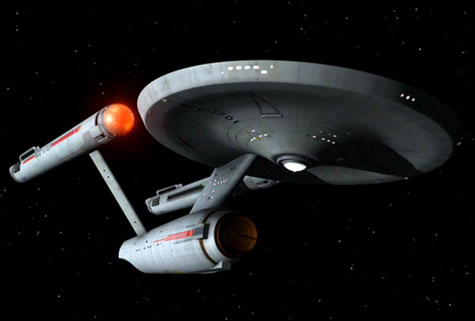As we reach the end of the third season and prepare to pack up the DVDs, it seems time to take a moment and look back over Star Trek’s final 24 original episodes and consider their merits, faults, and hidden meanings. It’s been an uneven season, disappointing or even boring at times, but also marked by a few surprisingly good highlights.
Let’s begin with an episode-by-episode breakdown of our ratings, in broadcast order:
| Ep. # | Title | David’s Rating | Dayton’s Rating | |
| 1. | 3×06 | “Spock’s Brain” | 1 | 1.5 |
| 2. | 3×07 | “The Enterprise Incident” | 5 | 5 |
| 3. | 3×03 | “The Paradise Syndrome” | 3 | 4 |
| 4. | 3×05 | “And the Children Shall Lead” | 0 | 0 |
| 5. | 3×07 | “Is There in Truth No Beauty?” | 5 | 4 |
| 6. | 3×01 | “Spectre of the Gun” | 6 | 5 |
| 7. | 3×11 | “Day of the Dove” | 4 | 3.5 |
| 8. | 3×10 |
“For the World Is Hollow and I Have Touched the Sky” |
3 | 3 |
| 9. | 3×09 | “The Tholian Web” | 6 | 6 |
| 10. | 3×12 | “Plato’s Stepchildren” | 2 | 1.5 |
| 11. | 3×13 | “Wink of an Eye” | 3 | 2.5 |
| 12. | 3×08 | “The Empath” | 5 | 4 |
| 13. | 3×02 | “Elaan of Troyius” | 4 | 4 |
| 14. | 3×16 | “Whom Gods Destroy” | 1 | 1.5 |
| 15. | 3×15 | “Let That Be Your Last Battlefield” | 3 | 2.5 |
| 16. | 3×17 | “The Mark of Gideon” | 1 | 1.5 |
| 17. | 3×14 | “That Which Survives” | 4 | 3 |
| 18. | 3×18 | “The Lights of Zetar” | 1 | 2.5 |
| 19. | 3×19 | “Requiem for Methuselah” | 4 | 4.5 |
| 20. | 3×20 | “The Way to Eden” | 0 | 1 |
| 21. | 3×21 | “The Cloud Minders” | 2 | 2.5 |
| 22. | 3×22 | “The Savage Curtain” | 2.5 | 2.5 |
| 23. | 3×23 | “All Our Yesterdays” | 5 | 4.5 |
| 24. | 3×24 | “Turnabout Intruder” | 2 | 2 |
Are there any ratings you would change?
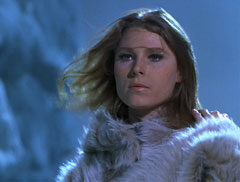 David: In retrospect, I think I might shift “Spectre of the Gun” from a 6 to a 5, to penalize it for its inexplicable motivation for the mission. I might also downgrade “That Which Survives” to a 3.5 for its sluggish pacing. Also, if I was grading on a curve, I’d bump “All Our Yesterdays” up to a full Warp 6 for being so much better than most of the other episodes in the final season.
David: In retrospect, I think I might shift “Spectre of the Gun” from a 6 to a 5, to penalize it for its inexplicable motivation for the mission. I might also downgrade “That Which Survives” to a 3.5 for its sluggish pacing. Also, if I was grading on a curve, I’d bump “All Our Yesterdays” up to a full Warp 6 for being so much better than most of the other episodes in the final season.
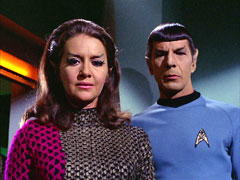 Dayton: Just to buck the trend, I think I might’ve rated “Spock’s Brain” a teeny bit higher. It’s an easy target for mockery, but after watching the entire season with fresh eyes, it’s really not as big an odious pile of tribble droppings as the casual viewers and bandwagon types say it is. This opinion only gets reinforced after suffering through “The Way to Eden” and “Plato’s Stepchildren.” On the other hand, I think I should’ve given higher ratings to “The Enterprise Incident” and in particular “The Empath,” for which I gained a new appreciation thanks to this exercise.
Dayton: Just to buck the trend, I think I might’ve rated “Spock’s Brain” a teeny bit higher. It’s an easy target for mockery, but after watching the entire season with fresh eyes, it’s really not as big an odious pile of tribble droppings as the casual viewers and bandwagon types say it is. This opinion only gets reinforced after suffering through “The Way to Eden” and “Plato’s Stepchildren.” On the other hand, I think I should’ve given higher ratings to “The Enterprise Incident” and in particular “The Empath,” for which I gained a new appreciation thanks to this exercise.
Best episode? Favorite episode?
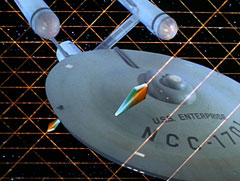 David: Best? “The Tholian Web.” It has everything you could ask for in a Star Trek episode: great effects, dire consequences, exotic aliens, a creepy mystery, and moments of great angst for our principal characters that deepen their friendships. Which episode is my favorite? It’s a tie between “Requiem for Methuselah” and “All Our Yesterdays.” I love the tantalizing ideas put forth in Jerome Bixby’s eloquent tale of immortality and identity, but I also love Jean Lisette Aroeste’s emotional tale of lives displaced in time.
David: Best? “The Tholian Web.” It has everything you could ask for in a Star Trek episode: great effects, dire consequences, exotic aliens, a creepy mystery, and moments of great angst for our principal characters that deepen their friendships. Which episode is my favorite? It’s a tie between “Requiem for Methuselah” and “All Our Yesterdays.” I love the tantalizing ideas put forth in Jerome Bixby’s eloquent tale of immortality and identity, but I also love Jean Lisette Aroeste’s emotional tale of lives displaced in time.
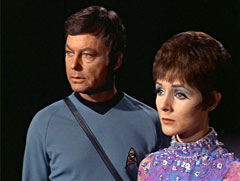 Dayton: I’m sticking with “The Tholian Web,” “The Enterprise Incident,” and “All Our Yesterdays” as the season’s highlights. They’re also among my favorite episodes across the entire series That said, rewatching all of these has reminded me why I liked other episodes which others might dismiss, such as “Spectre of the Gun.” As I said up above, I received a new appreciation for “The Empath,” but my opinions of episodes such as “The Paradise Syndrome” and “Requiem for Methuselah” were improved.
Dayton: I’m sticking with “The Tholian Web,” “The Enterprise Incident,” and “All Our Yesterdays” as the season’s highlights. They’re also among my favorite episodes across the entire series That said, rewatching all of these has reminded me why I liked other episodes which others might dismiss, such as “Spectre of the Gun.” As I said up above, I received a new appreciation for “The Empath,” but my opinions of episodes such as “The Paradise Syndrome” and “Requiem for Methuselah” were improved.
Most disappointing episode?
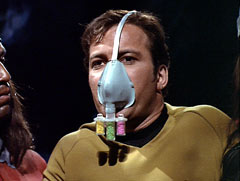 David: To call an episode disappointing implies that I had hopes it would be better than it was. That’s a distinction that rules out such abominations as “Spock’s Brain,” “And the Children Shall Lead,” and “The Way to Eden,” all of which I’d remembered as being especially awful. I would say that the episode I least recalled before rewatching and most hoped to like but didn’t was “The Cloud Minders.”
David: To call an episode disappointing implies that I had hopes it would be better than it was. That’s a distinction that rules out such abominations as “Spock’s Brain,” “And the Children Shall Lead,” and “The Way to Eden,” all of which I’d remembered as being especially awful. I would say that the episode I least recalled before rewatching and most hoped to like but didn’t was “The Cloud Minders.”
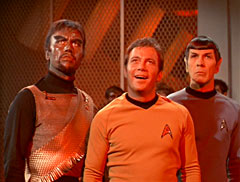 Dayton: “And the Children Shall Lead” remains my most-loathed episode not only of the season but also the entire series. Other episodes which I felt didn’t deliver on the potential to be found in their premise include “Requiem for Methuselah,” “Day of the Dove,” and “The Savage Curtain.” In both cases, budget likely was the biggest obstacle standing in their way, and the writers and production crew should probably be commended for what they were able to manage given the limitations they faced. “Let That Be Your Last Battlefield” and the “The Cloud Minders” each had the opportunity to provide an intriguing parable, but couldn’t stop beating us over the head with their fumbling attempts at oh-so clever “subtlety.”
Dayton: “And the Children Shall Lead” remains my most-loathed episode not only of the season but also the entire series. Other episodes which I felt didn’t deliver on the potential to be found in their premise include “Requiem for Methuselah,” “Day of the Dove,” and “The Savage Curtain.” In both cases, budget likely was the biggest obstacle standing in their way, and the writers and production crew should probably be commended for what they were able to manage given the limitations they faced. “Let That Be Your Last Battlefield” and the “The Cloud Minders” each had the opportunity to provide an intriguing parable, but couldn’t stop beating us over the head with their fumbling attempts at oh-so clever “subtlety.”
David’s Final Thoughts on Season 3
It’s difficult to say anything new or insightful about Star Trek’s ill-fated third season that others have not already said. Critics have pored over the declining quality of the series’ stories and scripts, fans and film historians have discussed ad nauseam the deleterious impact of the show’s decreased per-episode budgets, and memoirs by the stars and producers have documented the effects of on-set friction and network interference in the creative process. (Read more about this on Memory Alpha.)
The upheavals in the writing and production staff clearly affected the quality of the scripts. Star Trek crafted some thoughtful political allegories in the first and second season, but the third season’s offerings in that vein—“Day of the Dove” and “Let That Be Your Last Battlefield”—come off as simplistic and absurd by comparison to “A Private Little War” and “A Taste of Armageddon.”
Part of the reason the third season feels cheap and claustrophobic by comparison to the first two was the sharp reduction in location shooting, a cutback necessitated by the show’s slashed budget. The only two episodes of season three to feature location shots were “The Paradise Syndrome” and “All Our Yesterdays”—both of which, perhaps coincidentally, we ranked among the season’s better hours.
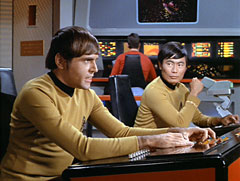 If the loss of funding hurt the show in many ways, it might have inadvertently helped it in others. Forced to focus on characters rather than on locations or effects, the producers seemed to make more effort to write stories that engaged all the members of the cast over the course of the season. While Kirk, Spock, and McCoy continued to be the show’s above-the-line stars, the supporting cast all got their moments of note. Uhura shared a controversial forced kiss with Kirk, McCoy and Scotty each got a chance to fall in love, and even young Pavel Chekov got a chance to reconnect with an old flame. As usual, Kirk got the majority of the romantic action, but Spock had his share of attention from the ladies, including a doomed romance on par with Kirk’s star-crossed love with Edith Keeler in season one. Even Sulu got a couple of turns in the command chair, starting with the season’s first broadcast episode, “Spock’s Brain.”
If the loss of funding hurt the show in many ways, it might have inadvertently helped it in others. Forced to focus on characters rather than on locations or effects, the producers seemed to make more effort to write stories that engaged all the members of the cast over the course of the season. While Kirk, Spock, and McCoy continued to be the show’s above-the-line stars, the supporting cast all got their moments of note. Uhura shared a controversial forced kiss with Kirk, McCoy and Scotty each got a chance to fall in love, and even young Pavel Chekov got a chance to reconnect with an old flame. As usual, Kirk got the majority of the romantic action, but Spock had his share of attention from the ladies, including a doomed romance on par with Kirk’s star-crossed love with Edith Keeler in season one. Even Sulu got a couple of turns in the command chair, starting with the season’s first broadcast episode, “Spock’s Brain.”
It’s also interesting to me how little we saw of the alien antagonists most closely associated with Star Trek. Klingons appeared in only two episodes, “Day of the Dove” and “The Savage Curtain,” and they figured off-screen in one other, “Elaan of Troyius.” The Romulans appeared only once, in “The Enterprise Incident.” Only once did we see a Vulcan other than Spock, Surak in “The Savage Curtain,” and our only glimpses of a Tellarite, an Andorian, and an Orion all came in the same episode, “Whom Gods Destroy.” I’m also intrigued by the profound impact the Tholians made in their only original-series 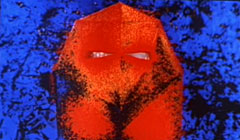 appearance and only on-screen appearance until Star Trek Enterprise. No other one-shot Star Trek alien (except maybe the Gorn) seemed to capture fans’s imaginations more vividly, and I think it was perhaps because of how little we saw of the Tholians.
appearance and only on-screen appearance until Star Trek Enterprise. No other one-shot Star Trek alien (except maybe the Gorn) seemed to capture fans’s imaginations more vividly, and I think it was perhaps because of how little we saw of the Tholians.
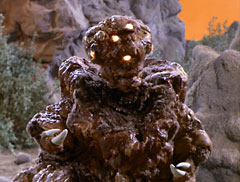 I won’t lie: the final season of the original series was disappointing in many respects. Some of the blame can be laid at the doorstep of the network, which cut the show’s funding; some rightly deserves to be placed upon the writers, who rehashed ideas from previous seasons or relied too heavily on clichés or stereotypes; some of it can be attributed to politics and egos (Star Trek’s exile to the dreaded Friday-at-10 PM time slot was caused by a tantrum from the executive producer of Laugh-In, who objected to his top-rated show being bumped half an hour later on Mondays to accommodate Star Trek’s preferred earlier airtime), and some of it can be chalked up to bad luck, such as the mid-season departure of veteran cinematographer Jerry Finnerman, and his replacement with the much less experienced camera operator Al Francis.
I won’t lie: the final season of the original series was disappointing in many respects. Some of the blame can be laid at the doorstep of the network, which cut the show’s funding; some rightly deserves to be placed upon the writers, who rehashed ideas from previous seasons or relied too heavily on clichés or stereotypes; some of it can be attributed to politics and egos (Star Trek’s exile to the dreaded Friday-at-10 PM time slot was caused by a tantrum from the executive producer of Laugh-In, who objected to his top-rated show being bumped half an hour later on Mondays to accommodate Star Trek’s preferred earlier airtime), and some of it can be chalked up to bad luck, such as the mid-season departure of veteran cinematographer Jerry Finnerman, and his replacement with the much less experienced camera operator Al Francis.
A few of the episodes in season three were simply awful… but you know what? So were a few episodes from each of the first two seasons. Remember “Miri”? Or “The Alternative Factor”? What about “Catspaw”? Or “The Omega Glory”? When measured against the entire run of the series, season three might be a bit more uneven, and its lows might be lower than those that had come before, but it had its high points, too. Considered in context, it remains a worthy staple of classic science fiction, and deserves as much praise as the preceding two seasons.
Star Trek, season three … I salute you.
Dayton’s Final Thoughts on Season 3
What David said.
Okay, okay.
Sitting here and considering this 24-week journey we’ve just completed, I keep coming back to something I mentioned during our write-up of “Requiem for Methuselah.” During my analysis of that episode, I quoted producer Robert H. Justman from the book he co-wrote with Herbert F. Solow, Inside Star Trek: The Real Story, because he brings into stark relief what I think was the main problem of the show’s final season. I won’t make you go looking for that quote, so here it is again:
JUSTMAN: I despaired about the show’s loss of quality. By the time episodes were filmed, whatever excitement existed in the original stories and scripts had been diluted by a rewriting process that was no longer overseen by Gene Roddenberry; it was strictly budget-driven. There were no highs and no lows—just a boring in-between. My never-ending battle to cut costs without compromising quality had failed. The Star Trek I knew, and was proud to be a part of, was no more.
(And while we’re here, let me just say that Inside Star Trek is one of the more engaging accounts on the making of the original series that I’ve ever read, written by two of the three men who were there from day one. Be warned that it’s not simply a gushing celebration of the series; instead, it’s a rather unvarnished retrospective from the viewpoint of two men whose job was to get and keep the show on the air despite all the obstacles standing in their way. Unfortunately, both the hardcover and trade paperback editions of this book are out of print, though used copies can still be found. That said, if you have any interest at all in how the show was created, developed, and nurtured, this book is definitely worth hunting down.)
As Mr. Mack pointed out, the budget took its toll on nearly every third season episode. As a trailer for the Star Trek DVD season sets once proudly proclaimed, “In 1966… the future… was funky.” The bold, dynamic camera angles and lighting that so ably served Star Trek during its first year and really worked to make it look like a glimpse into the future were long gone by the time the first Season 3 episode started shooting.
Of the twenty-four episodes filmed, only two included filming on location rather than being confined to the now well-worn Enterprise and planet exteriors sets. Where the Enterprise corridors once seemed packed to overflowing with crew members hustling to some unknown destination, with few exceptions they now were the sole domain of our regular cast and the week’s guest character, along with the infrequent security guard or two.
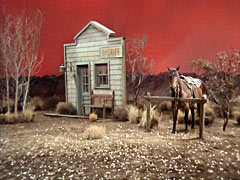 Still, credit must be given to the writers and production staff for finding at least a few ways to work around some of these limitations. I might not like “The Mark of Gideon,” but at least it was an “outside the box” way of doing a bottle show, and production designer Matt Jefferies was able on more than one occasion to rise to the challenge of providing interesting sets and visuals, such as in “Spectre of the Gun” and “The Cloud Minders.”
Still, credit must be given to the writers and production staff for finding at least a few ways to work around some of these limitations. I might not like “The Mark of Gideon,” but at least it was an “outside the box” way of doing a bottle show, and production designer Matt Jefferies was able on more than one occasion to rise to the challenge of providing interesting sets and visuals, such as in “Spectre of the Gun” and “The Cloud Minders.”
We could spend all day lamenting however many things that went wrong with Star Trek’s third season, but let’s also pay proper kudos to what it got right. “The Tholian Web” and “The Enterprise Incident” are genuine high points of the entire series, bringing with them a few nice bits of lore—the Tholians and the U.S.S. Defiant; the Romulan Commander and the Klingon-Romulan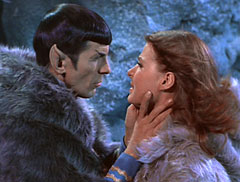 alliance—which remain popular with fans to this day. As we discussed in our write-up for “All Our Yesterdays,” the tragic love affair between Spock and Zarabeth provided inspiration for two Star Trek novels from Pocket Books, Yesterday’s Son and Time for Yesterday, which continue to be listed among reader favorites.
alliance—which remain popular with fans to this day. As we discussed in our write-up for “All Our Yesterdays,” the tragic love affair between Spock and Zarabeth provided inspiration for two Star Trek novels from Pocket Books, Yesterday’s Son and Time for Yesterday, which continue to be listed among reader favorites.
Even episodes that stumbled still were able to provide memorable characters which later played key roles in the various Star Trek spin-off series, such as the Klingon commander Kang from “Day of the Dove” along with Kahless the Unforgettable and Surak of Vulcan from “The Savage Curtain.” As Mr. Mack mentioned, the writers seemed to use the additional 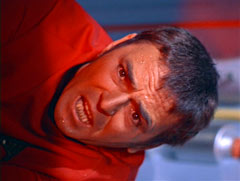 production restraints to make better use of the supporting characters, giving Sulu, Chekov, Uhura and Scotty in particular moments to shine. One also could argue that some of the better Spock/McCoy moments can be found in third-season episodes, with the true highlights coming in “The Tholian Web” and “All Our Yesterdays.”
production restraints to make better use of the supporting characters, giving Sulu, Chekov, Uhura and Scotty in particular moments to shine. One also could argue that some of the better Spock/McCoy moments can be found in third-season episodes, with the true highlights coming in “The Tholian Web” and “All Our Yesterdays.”
So, long story short? I came through this “rewatch” exercise still hating those episodes I’d always hated, but I also gained newfound respect (or found the respect I’d misplaced at some point over the years) for several of those “middle of the road” installments. Even with the clunkers, stinkers, and just plain howlers, Star Trek’s third season still has many good things going for it. While Dave and I took more than our share of potshots over the past 24 weeks, I hope we also succeeded in pointing out some of the season’s oft-overlooked bright spots along the way.
Resources
Neither of us claims to have photographic memories, and we certainly aren’t as versed in the lore and trivia of Star Trek as one might expect for people who earn money writing stories based on it. In order to fill out these weekly columns with illuminating historical tidbits, we have resorted to the use of several exemplary reference tomes that no Star Trek fan should be without.
The first is The Star Trek Compendium by Allan Asherman. This guide to the episodes of the first three seasons and five feature films is an indispensable first stop in our academic plumbing of the original series. Next up is the exhaustive Star Trek Encyclopedia by Michael Okuda and Denise Okuda. There’s no better printed guide to the tiny details of the sprawling Star Trek universe. For an awesome look behind the scenes, pick up Star Trek 365 by Paula Block. Last but not least, for quick reference as well as obscure trivia, we’ve relied on the superb wiki-based website Memory Alpha.
One major shift from previous seasons of the Star Trek Re-watch is that we digitized and prepared all our own frame-grabs from the original series. Also, while our predecessors had the luxury of watching the original-series episodes for free on the CBS website, Dayton and I both owned copies of the entire original series (and, in Dayton’s case, the “remastered” versions, as well) on DVD. This proved fortunate near the end of our third-season viewing when CBS removed all the full episodes of the original series from its site without warning or explanation.
The moral of that story? If you really enjoy something, stop taking it for free on the internet and go buy it. Because the interwebs giveth, and the intertubes taketh away.
We’ll be back next week, so don’t delete your Re-watch bookmarks just yet!
Next: A special bonus rewatch! The original series pilot — “The Cage.”
Check the Star Trek Re-Watch Index for a complete list of posts in this series.
David Mack is the national bestselling author of nearly twenty Star Trek novels and novellas, and the cowriter of two episodes of Star Trek: Deep Space Nine.
Dayton Ward also writes Star Trek novels as well as content for Star Trek Magazine, and on occasion still manages to write his own science-fiction and horror stories. He also used to host Star Trek trivia on America Online. No, nobody else ever thought that was cool, either.










